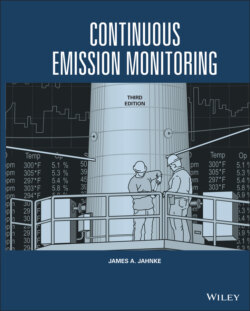Читать книгу Continuous Emission Monitoring - James A. Jahnke - Страница 108
Theoretical Corrections.
ОглавлениеAlthough the theory of the critical orifice has been examined in detail, the construction and operation of dilution probe and its analogues may not satisfy all the underlying assumptions of the theory. Theoretical aspects of dilution systems were studied by Munukutla (1992) and Jahnke and Marshall (1994), Romero and Associates (1999), and Batug and Associates (2004). The extended formulation of Jahnke is provided here.
Dilution system theory begins from the theoretical equation for critical flow (see ASME 1971; Green and Perry 2007; Sadegh and Worek 2017; Shapiro 1953). This equation is used to obtain a corrected dilution ratio, D, from a new set of gas conditions that differ from the conditions under which the system was originally calibrated for the initial dilution ratio, Do (Jahnke and Marshall 1994; Munukutla 1992):
(3‐8)
Instead of using Equation 3‐3 (c = cmeasDo) to calculate the source‐level concentration from the measured analyzer data, the following equation can be used to correct the data to the actual conditions of measurement:
(3‐9)
This equation has been shown to adequately represent the effect of pressure and molecular weight changes on dilution system data (note: it is simplified by not incorporating changes in specific heat) (Jahnke and Marshall 1994; McGowan 1994; Miller 1994). Critical orifice theory predicts that the temperature variation . However, this expression is incomplete since it does not account for changes in the dilution air temperature. Baugham (1996) has done this and has developed an instrument control method that corrects for both probe and dilution air temperature variations. In later work, Romero et al. (1999) and Batug et al. (2004) applied computational fluid dynamic techniques to develop a model for evaluating temperature, pressure, and molecular weight effects in the EPM dilution probe.
Equation 3‐9 is especially useful for calculating molecular weight corrections that would apply to changing flue gas composition or cylinder gas audits using different gas blends. One can simply input the molecular weight of the initial calibration gas, Mo, and correct subsequent readings if the molecular weight of the test gas, M, is known.
Note that these corrections may not be necessary if data are reported as an emission rate, E, in terms of lb/mmBtu (ng/J). If emissions are reported in units of lbs pollutant emitted/106 Btu generated (or ng/J),
the F factor expression can be used (see Appendix A).
(3‐10)
where
Fc = “F” factor in scf/106 Btu
c = pollutant gas concentration
Because the pollutant concentration is divided by percent CO2, any constant change in the dilution ratio cancels out in the concentration ratio. When reporting emission mass rates in pounds/hour, the pollutant mass rate equation is not expressed in a form where flue gas density effects on the dilution ratio cancel, and changes in the flue gas density must be taken into account.
